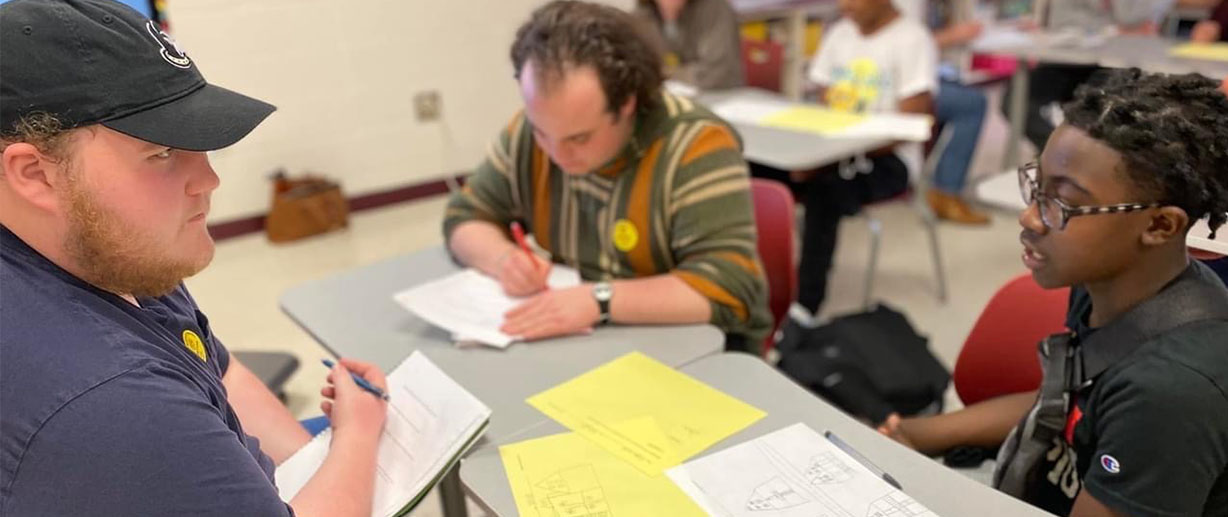Regan Hood ’20 read stories about Wofford College students and faculty conducting research in Spartanburg County’s Una, Saxon and Arcadia neighborhoods last summer and thought a visit from the professors would be helpful for her seventh-grade geography students at Carver Middle School.
Dr. Jennifer Bradham, assistant professor of environmental studies, and Dr. Alysa Handelsman, assistant professor of sociology and anthropology, received the invitation and asked if they could do more. Now, Bradham, Handelsman and Hood have spent most of the academic year working together to teach both Wofford and Carver students about mixed-methods research and conducting research alongside them.
“Every day the students ask if Wofford can come today,” says Hood, who is in her third year teaching at Carver. “It’s given me a lot of insight, and I plan to take these lessons into next year.”
Bradham, Handelsman and their students have led the Carver students in lessons involving geographic information systems and mapping exercises, both of which helped them get a better understanding of geographic scale, including boundaries for neighborhoods, cities, counties and districts for elected officials. Carver students also engaged in a series of exercises, including one-on-one and group interviews, to discuss and design dreams for their neighborhoods.
On Thursday, May 18, Hood’s students, along with Ralph Fowler’s seventh-grade students from McCracken Middle School and their Wofford student collaborators, will host a data walk around the C.C. Woodson Community Center to showcase what they have learned through several months of research. The community is invited to participate and provide feedback during this interactive presentation. The event will be from 6-8 p.m. with a meal provided.
The project is titled “Imagining Spartanburg: A Comparative Neighborhood Study of Youth Perspectives on Daily Life and Community Sustainability.” Carver students will share their vision for the city’s Southside, Highland and other neighborhoods, including ideas on increased safety measures and open spaces with more parks, pools and athletic fields.
Spartanburg residents and community leaders will attend. Handelsman, Bradham and Hood hope the data walk will result in productive conversations.
“I hope the students experience that their voices can be heard and lead to change,” Hood says.
Bradham’s quantitative methods students have helped calculate survey and interview responses and map results.
“We’ve been interested in what residents call neighborhoods and how they define boundaries compared to the city’s names for neighborhoods and boundaries,” Bradham says.
Handelsman’s ethnography students have conducted interviews and group mapping exercises to learn more about the thoughts and opinions of Carver students relating to their lived experiences in Spartanburg.
“This work is community-driven, and in conversations with Southside leadership, the hope is that youth perspectives may contribute to the Southside neighborhood masterplan,” Handelsman says.
Since February, Wofford students have totaled attendance at more than 200 community events, including PTO meetings, neighborhood association meetings and exercise classes at C.C. Woodson, to get a better understanding of the community.
Foster Kemp ’26, an undeclared major from Spartanburg, describes his time with the Carver students as eye-opening.
“Living in Spartanburg my entire life, I've always thought I had a great knowledge of the city,” says Kemp, who’s assisted with qualitative research. “During this collaboration with students, I realized my knowledge wasn't as thorough as I thought. My knowledge of Spartanburg has been limited to where I live, on the east side. Going to Carver and attending community meetings has given me a new view on Spartanburg.”
Anthony Tarulli ’24, a biology and environmental studies major from Bluffton, South Carolina, enjoyed watching the students embrace new experiences.
“One of my favorite moments was when the middle schoolers visited Wofford to digitize their maps,” says Tarulli, who primarily focused on data involving life expectancy based on race, income and neighborhood. “It was amazing to see kids’ faces light up when we allowed them to start using the software. I was happy to see some of the kids take control of the computer when they were given the chance.”
Wofford students also learned new skills.
“My students have emerged as researchers. They now know what to ask, when to ask and how to listen,” Handelsman says. “It’s exciting to watch that growth and to see they’re involved with a project that can have an impact.”
Bradham and Handelsman plan to work with students at District 7 elementary schools next academic year on the same project and would like to eventually conduct research with high school students. McCracken students began participating in the research later in the academic year, and Bradham and Handelsman are inspired by the comparative discussions across schools and the bridge-building potential these multi-school collaborations hold.
Hood appreciated how her students learned new skills and received opportunities to visit Wofford’s campus and use mapping software.
“This has made geography fun and come alive for them,” Hood says.
